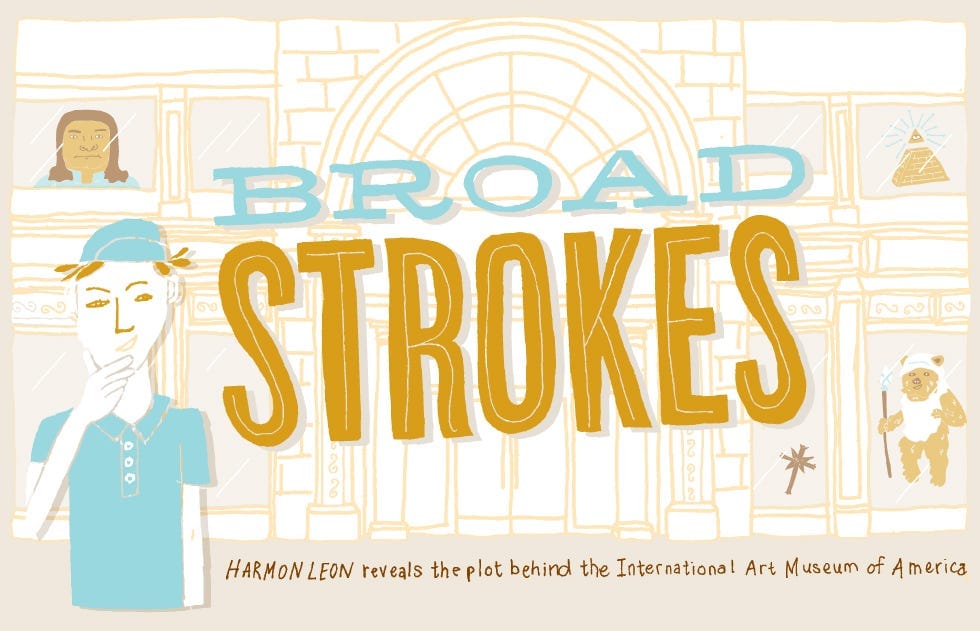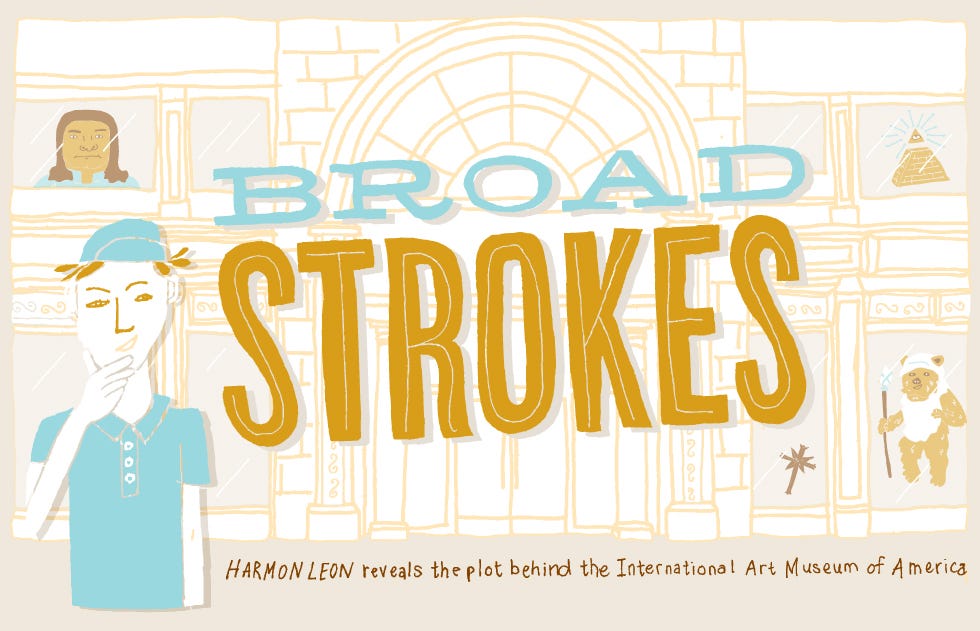

I’ve walked by the building numerous times and it’s shrouded in mystery. It just appeared one day on Market Street with a gold-lettered sign. What does that name mean? Was it originally going to be called Supreme Greatest Art Museum of United States #1 Hurrah!? Peering into the large windows offers strange clues: a footbridge and large artificial trees that look right out of an Ewok forest from Return of the Jedi .
The first thing that comes to mind: Scientology. Is this L. Ron Hubbard brood’s latest attempt at re-branding? Will a tour of the International Art Museum of America conclude with being hooked up to an e-meter while signing up for numerous expensive courses?
My passion for The Da Vinci Code author Dan Brown’s novels concocted greater fears. Maybe the International Art Museum of America is run by the Illuminati, the shadowy “power behind the throne” controlling world affairs that will lead to the establishment of a New World. Thus the bizarre name, authoritative-looking building, and vague representation of what is inside.
Whispered discussions with an Illuminati expert — the guy who sells me weed — confirm my suspicions. Further mystery: I have never seen anyone enter or leave the International Art Museum of America.
No more putting it off. I have to learn the secrets within. It’s time to face my worst fears and take a trip inside the International Art Museum of America. I will expose the Truth!

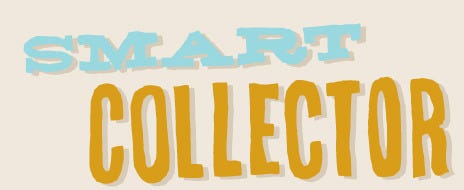

I send an email to the International Art Museum of America asking for a press tour, with full knowledge that I’m risking having my address added to a government watch list, after which I’ll be whisked away to a CIA black site for interrogation. I’m sure contacting the International Art Museum of America is as ludicrous as emailing Bohemian Grove and asking to pop over for tea and biscuits.
Astonishment: The museum’s curator, Dyana Curreri-Ermatinger, is more than cooperative to grant my request. Obviously, this is a cruel game of smoke-and-mirrors to put on a public face that convolutes the true conspiracy behind the complex.


At precisely 1 p.m. on June 14, I journey inside the museum’s doors, contemplating whether I’ll be awarded a medal of valor for exposing the latest façade behind the Illuminati’s elaborate plot. I’m greeted by Dyana in the lobby, which has elaborately tiled floors that look right out of Bellagio in Vegas.
“Have you been here before?” the very bubbly woman asks upon my arrival. I tell her I haven’t, but that I’ve always been curious about the nature of the place.
“We’ll start here then,” she says, leading me to a table with a variety of tile samples. “You see all through the museum that contractors have designed a wide variety of tile.” She goes on to explain that collections of tile are also sold to other contractors to help fund the museum.
I make a quick connection. The Freemasons — henchmen of the Illuminati — also worked with tile! Dyana has immediately disclosed blatant Masonic influences, with the clues hidden in plain sight.
“So these tile companies are like the sponsors of the museum?” I inquire with a wink, signaling that I’m on to the overall agenda.
She says that they’re more than sponsors; they helped provide the overall design of the building. “We’re always looking at new ways of getting revenue,” she adds, explaining that it’s tough to fundraise through old avenues such as individual donations.
As the tour continues, Dyana says the three-level museum was modeled on 32 different traditional Korean, Indian, and Chinese buildings. “Visitors from Asia might be familiar with the look, but to Americans the ornate design might look like Versailles,” she adds as we pass a pair of giant Chinese guardian lions perched at the mouth of a large gate.
“So what is the theme of the museum? What is it all about?” I ask, assuming the answer will be a fabricated backstory. “We’re really trying to create a serene environment. Sort of a refuge right here on Market Street. When you step outside the door, it’s chaos,” she says.
Peaceful? How peaceful will it be when I’m soon chased through the streets of Paris like symbologist Robert Langdon and by a psychopathic albino because I’ve come close to cracking the Da Vinci code of the International Art Museum of America?
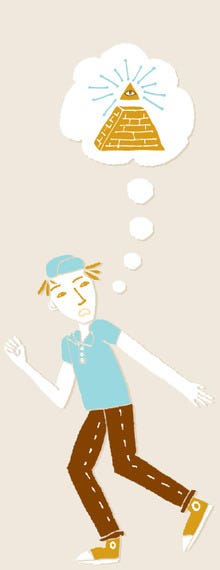



Passing the Ewok footbridges and trees, we make our way up to the top floor that houses the museum’s permanent collection. Eyeing some hand-sculpted coral and paintings of birds, insects, and surreal landscapes, I summon the courage to ask, “How did you come up with the name of the museum?”
“It’s really a vision piece,” Dyana says with a smile, obviously crafting her words carefully so as not to fully expose a global framework that will somehow lead to all of us living in government-run FEMA camps. “We have mostly Korean and Chinese art. But someday we hope to attract artists from Africa, South America, and Europe.”
My New World Order theory has been openly admitted to!
The layers of the onion begin to unravel. Now I’m made to peer into a sculpture that represents dripping stalactites in a cave. It’s so otherworldly, perhaps it was created by the Anunnaki race who have come to Earth to wrest control for the reptilian agenda.
“Is this museum part of a larger group around the world?” I inquire, with a knowing grin acknowledging an unduly influential cabal.
“No, we basically started with the work of one artist,” Dyana explains. (L. Ron Hubbard?) “He happens to be leader of the Buddhist community. His name is Dorje Chang Buddha III. He has been working since he was 18 years old as a painter, calligrapher, and sculptor.”
The official story? The International Art Museum of America houses the work of H. H. Dorje Chang Buddha III. His art involves the basic Buddhist tenets: treat people well, love the environment, and create a peaceful world. The museum honors him because he donated six pieces to help start the permanent collection. Right now there are 13 permanent works along with regular exhibitions of Asian art. Dyana explains that the overall vision is to create a peaceful space that encourages people to respect themselves and the world around them.
Like a soft gel lens suddenly brought into sharp focus, this whole plot is becoming clear. I look around at the gallery and notice artwork with strong symbolic connections to nature. There’s abstract work, mystic realism, super-realism, calligraphy, and a combination of different styles. Giant sculptures of boulders. Paintings of apple blossoms. Images replicating jade, caves, and other organic materials that are metaphors for ancient wisdom. They’re pleasing to the eye and comforting to the mind.
This Illuminati scheme to create a façade of an art museum really is just an art museum filled with Asian Buddhist art.
A eureka moment: I’ve cracked the International Art Museum of America’s Da Vinci code.
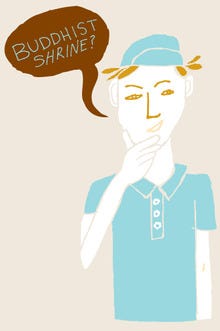
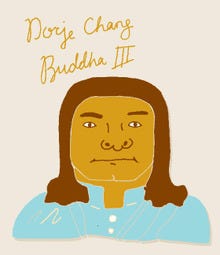

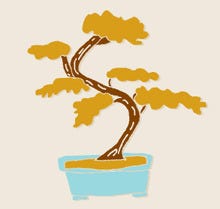

Why not take a journey to the best-named museum in town? You can visit the International Art Museum of America Tuesday through Sunday 11 a.m.–5 p.m. The admission is $8. The museum’s soft launch was in March and its official launch will be in October. Be sure to check out some great Buddhist art and original tile.



